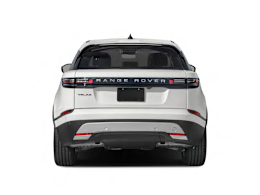Once you start driving the new Land Rover Range Rover Velar, it's obvious this compact luxury SUV is a new breed of Land Rover. Rather than an off-road-ready, adventure-seeking, rugged SUV, the Velar is a sleek, sporty machine. It sits lower than other Land Rovers and takes corners better, with quick steering and graceful handling over undulating roads. The Velar shares a platform with its corporate cousin, the Jaguar F-Pace, which itself was derived from the Jaguar XF sedan.
Clearly, the Velar offers a different vibe than any other Land Rover. It greets you with retractable door handles reminiscent of the Tesla Model S. Once inside, attractive touch screens instill a sleek, high-tech ambience.
This Range Rover also sits lower than its brethren. It is more stiffly sprung and responds more sharply in corners than any other member of its extended family.
The 247-hp, 2.0-liter turbocharged four-cylinder engine does a commendable job of moving this 4,300-pound SUV, albeit the revs have to be piled on. A brief initial hesitation suggests a lack of urgency. The eight-speed automatic transmission shifts smoothly and decisively, but power delivery is spoiled by a rough start/stop system that announces itself with a jolt, which makes driving around town annoying. Frustratingly, shutting the system off requires wading through a settings menu after every restart. At 21 mpg overall, the Velar's fuel economy is not a standout.
Given that it is based on the sporty Jaguar XF and F-Pace, it's no surprise that the Velar is quite nimble. It takes sharp curves with restrained body lean, and the steering is quick, making the Velar one of the more athletic luxury SUVs. At the same time, however, the Velar has a rather stiff ride. A somewhat raspy engine sound mars the otherwise quiet cabin.
The driver's seat is firm and supportive, and most of our testers found the driving position to be decent. But we are dismayed that our $60,000 Velar lacks adjustable lumbar support for the driver's seat, and that the steering wheel adjustment is a clunky manual control.
Visibility isn't great. The thick roof pillars between the front and rear side windows obscure the view, and the side glass tapers toward the rear, which combine to make backing up and merging a challenge.
The Velar ushers in Land Rover's new dual touch-screen control system. Even though it looks sleek and modern, we found it to be unnecessarily fussy, requiring extra steps to perform common tasks. The upper screen contains audio, phone, and navigation functions and is fairly manageable. The lower screen consolidates climate functions, seat heaters, and other settings. Its position requires drivers to frequently look down and away from the road.
Forward collision warning, automatic emergency braking with pedestrian detection, blind spot warning, rear cross traffic warning, lane departure warning and lane keeping assistance are standard. However, the lane departure warning sends an annoying tremor through the whole vehicle to alert drivers that they are about to veer out of the lane, which prompted most test drivers to shut off the system, negating its helpfulness.
Overall, the Velar is a dynamically capable vehicle, but it is let down by its unintuitive controls, a stiff ride, and mediocre fuel economy.


























